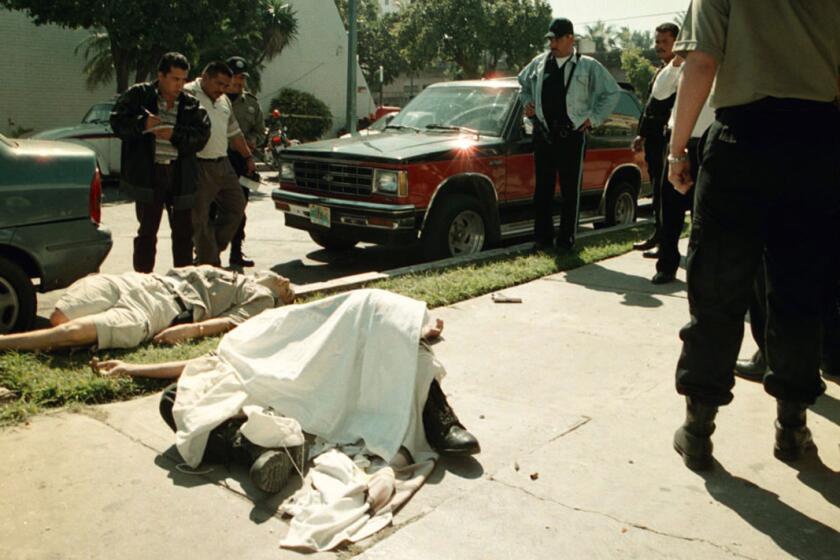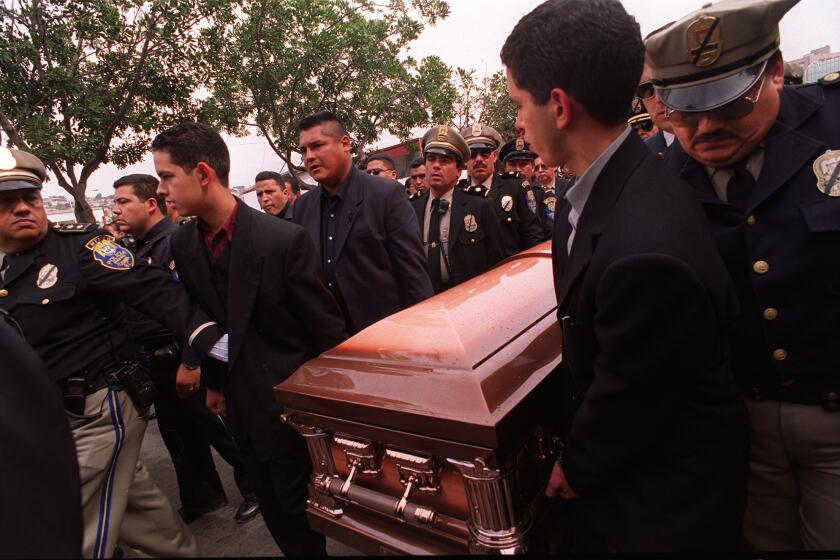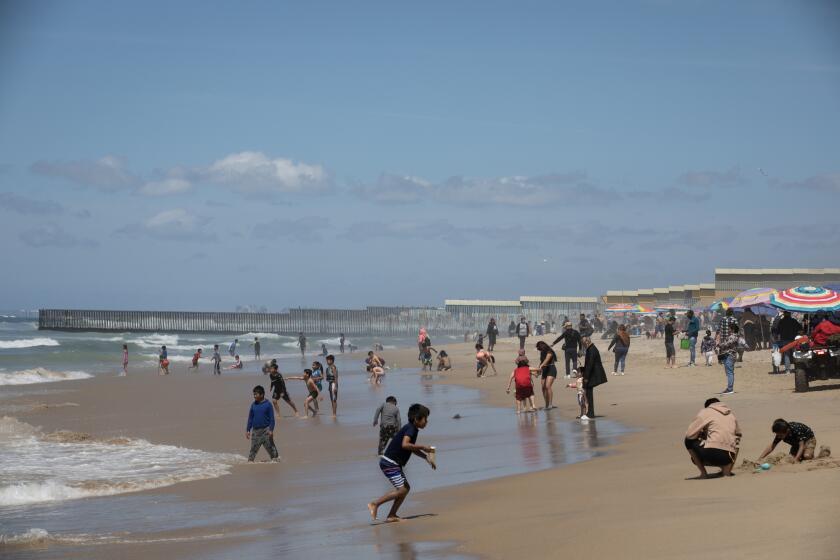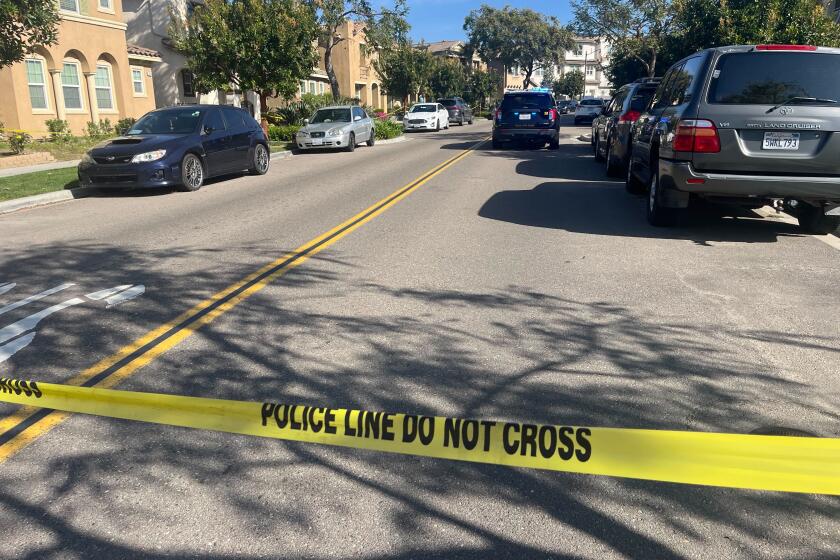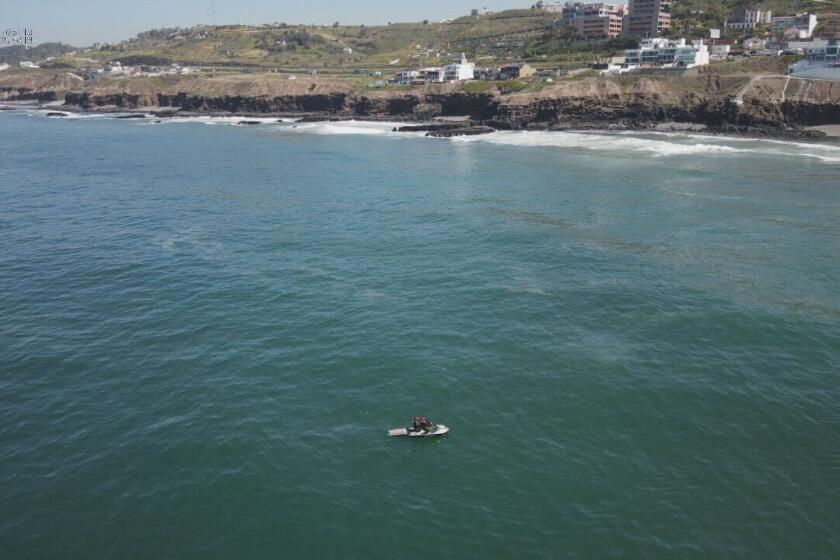Failed Baja condo project haunts U.S. buyers
Fueled by booming U.S. real estate prices, the summer of 2005 was a heady time for condo sales on Baja California’s Pacific coastline. That was when San Diegan Dean Marriott set his sights on The Residences at Playa Blanca, a luxury development under construction 12 miles from the border.
“I saw this project and fell in love with it right off the bat,” said Marriott, a 49-year-old accounting manager for a Burbank-based construction company. He and his soon-to-be wife, Connie, selected two eighth floor units in the project’s North Tower looking out over the Coronado Islands, and began counting the days when they could start driving down with their blended family of five daughters.
The developer, Coastal Design and Development Group (CDDG), promised a 2007 completion, but eight years later, the building sits empty and unfinished at Tijuana’s southern boundary, just off the coastal toll road to Rosarito Beach. Purchasers like the Marriotts, who signed contracts and deposited $254,000 for two units — half their sales prices — are facing a tough reality after years of hoping and waiting: Their investment, drawn from Connie Marriott’s retirement savings, may well be lost.
“Up until three or four months ago, everything was rolling along, investors were being found, and this project was going to be completed,” Marriott said in an interview last week at his Kearny Mesa office. “And then, all of a sudden, everybody went away.”
Neither representatives for the project’s development company, CDDG, nor the main creditor, Mexico’s Monterrey-based bank Banorte, have returned Marriott’s calls and emails. The blogs and company websites where buyers could receive updates about the project have been taken down. Banorte is said to have foreclosed on the property in recent weeks, but bank officers in Tijuana who have been overseeing The Residences declined interview requests last week.
Fearing the worst, Marriott and other buyers at the Residences are telling their story at a time when the coastal real estate market has been slowly picking up again after several difficult years of slow sales. Victor Loza, a real estate broker in the area and past president of the Real Estate Board of Baja California, said about 40 percent of the buyers are foreigners.
“We’re going back up, we’re selling,” said Luis Bustamante, a longtime real estate broker in the area. “The (housing) prices in the United States have been rising, and when that happens, people come and say, ‘I have equity.’”
With its Pacific Ocean ocean vistas, proximity to the border, and affordable prices, the Baja California coastline long has been popular with Southern Californians. Many U.S. citizens have purchased successfully, securing title through a bank trust as required under Mexican law, and found fulfillment of their dreams of owning oceanfront property in Mexico. But cases like The Residences at Playa Blanca have cast a cloud on the idyllic picture often portrayed by the region’s promoters — in many cases U.S. companies and individuals who came offering assurances that the investment would be secure.
For many projects along the coastal corridor from Tijuana to Ensenada, the promises came to a halt in 2008, as U.S. credit markets dried up. “Sales stopped 100 percent, and everyone ended up with bank debts that generated interest every day,” Bustamante said.
While developers of The Residences continued to look for financing to complete their project, another high profile project, Trump Ocean Resort Baja Mexico, never even broke ground. Purchasers who lost their deposit there sued and received a settlement in 2013 from Trump, who it turned out was not a partner but had only franchised his name to the project.
Bustamante said that today The Residences is one of about 10 coastal condominium buildings in the tourist corridor where banks have foreclosed. In some cases the bank has taken only a portion of the units, while in others the entire building. Every case is different, he said, with some buildings completed and occupied, with the bank in the process of recognizing the occupants’ ownership.
“It’s better to deal with a bank than a bankrupt company,” Bustamante said.
The Residences promised much: A development with 240 condos and a 114-room boutique hotel, with amenities that included four restaurants, a delicatessen, two pools, a private white-sand beach, a European spa and a nine-hole executive putting green, according to a promotional flyer.
The units offered double-pane windows, travertine tile floors, marble kitchen counters, and on clear days views all the way to Point Loma.
“Built to American standards by an American developer,” read a description given to prospective buyers. All deposits would be made to Stewart Title Company of California, a U.S. company that offered escrow services, it said, adding that “your money is safe.”
Like scores of developers on the Baja California coast, CDDG used the buyers’ deposits to finance construction. “Here it’s too expensive to borrow, so we use the money to build,” Jack Coskey, the owner of The Residences, told the San Diego Union Tribune in a 2005 interview.
The Marriotts were part of a group of 220 people with deposits totaling more than $30 million, said Ian Fusselman, a San Diego attorney whose firm, Thorsnes Bartolotta McGuire, represented some 90 buyers in several lawsuits in San Diego Superior Court. All of them settled with Stewart Title for the return of one-third of their deposits.
The firm has won a lawsuit against The Residences, but has yet to collect. “We are attempting to have liens placed against the project in Mexico,” Fusselman said.
Coskey, the co-owner of The Residences, had built more than 1,000 swimming pools, but until The Residences had never embarked on a major condominium and hotel project, according to his 2013 testimony in San Diego Superior Court. Still, he is said to have worked for years to keep the development going, seeking financing to complete the project.
But in the end his efforts failed. Coskey died several weeks ago, just as the bank was taking over, associates said. “There’s 100 different ways to make this a sad story,” Fusselman said. “Jack Coskey consistently said that he never intended to mislead anyone. I tend to believe that may be the case, but many buyers were told their money was safe.”
Alejandro Moreno Medina, Baja California’s tourism secretary at the time, still speaks highly of the project. “I saw the quality of the investment they were making, and the commitment they had with Baja California in building things the right way.”
Chris Hill, CEO of Stewart Title Latin America — which was not involved in The Residences — said that what happened in The Residences “you can multiply by 1,000 — Costa Rica, St. Kitts. There was a huge boom, a lot of these developers were not major corporate developers ... when the cycle came crashing in 2008, they didn’t have the financial structure in place.”
With limited credit available, using deposits to begin construction is a common practice in Mexico. Hill and others warn against such projects. “Buyers should not buy anything that is not complete, period,” real estate broker Loza said. “When you put a deposit on a building that is not completed, you’re running a risk, you’re getting a lower priced unit, but people should be aware that they may end up losing their investment.”
But José Larroque, who heads the Tijuana office of the law firm Baker & McKenzie, said expecting deposits to be held through a project’s completion in most cases “is a non-reality in Mexico, because you don’t have a system like in the U.S. where everything is completely funded.” In Mexico, he said, banks “would give you at most 50 percent on a project.”
Testifying at his civil trial in November 2013 in San Diego Superior Court, Coskey said The Residences and a second project across the toll road, One Eleven, was launched with a $2.9 million line of credit from Investors Mortgage in Nevada. The plan was to pay for the project through $50 million in deposits, and a $65 million loan from Banorte, Coskey said.
Even as financing was delayed, buyers said they were repeatedly reassured by both the developers and the bank that The Residences would be built. Buyers said told they were in a trust with Banorte, and that offered a guarantee that they could not lose their investment.“We are working to complete the project,” a Banorte officer wrote in an email to Marriott in 2013.
But another buyer, Martin Valdez, said he was told last week by another Banorte officer that the bank has no obligation to the buyers, and suggested they go after the developer for the return of their deposits.
Jim Holliday, a 56-year-old database architect, said he invested $118,000 between the deposit and upgrades to his unit. Losing the funds “is a retirement blow,” he said. “I was thinking that this was going to be my retirement.”
Like others he is still hoping for resolution. The hope is for “Banorte to come through,” he said, “behave ethically and honor our sales contracts, complete the project and deliver completed units to the investors.”
Get Essential San Diego, weekday mornings
Get top headlines from the Union-Tribune in your inbox weekday mornings, including top news, local, sports, business, entertainment and opinion.
You may occasionally receive promotional content from the San Diego Union-Tribune.





